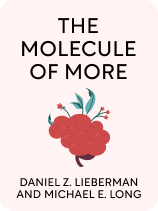

This article is an excerpt from the Shortform book guide to "The Molecule of More" by Daniel Z. Lieberman and Michael E. Long. Shortform has the world's best summaries and analyses of books you should be reading.
Like this article? Sign up for a free trial here.
How can we understand how dopamine affects behavior? Can the amount of dopamine you have influence your relationships and beliefs?
Dopamine affects behavior by making us look forward to the future and anticipate future happiness. A look at how this works can tell you a lot about where certain behaviors come from.
Read here to see how dopamine levels can affect everything from romantic relationships to political beliefs.
How Dopamine Affects Behavior
Dopamine influences what you want and how much you want it, but do we know how dopamine affects behavior? It does so in many different ways, some of which are quite unexpected.
In this article, we’ll discuss dopamine’s effects on romantic interest (love), how it can influence your political beliefs, and why dopamine is the basis of creativity—as well as of some mental illnesses. We’ll also explore how dopamine affects your desires and decision-making.
How Dopamine Affects Romantic Interest
The feeling of falling in love—the excitement and euphoria that sometimes seem to override logic—comes from your brain being flooded with dopamine.
This dopamine high happens because a new relationship is the basis of countless new “what if” scenarios, from fun date nights to buying a home and having children together. Since dopamine motivates you to pursue such possibilities, your brain responds to a new relationship (or even the chance of one) by producing huge amounts of it.
(Shortform note: One important aspect of some romantic relationships is the chance to reproduce. As biologist Richard Dawkins writes in The Selfish Gene, according to our genetics, reproduction is the ultimate purpose of life. Therefore, it makes sense that we’ve evolved so dopamine strongly motivates and rewards us for such relationships. Early humans who produced a lot of dopamine when given the chance to mate would have been the ones most likely to reproduce and pass on those dopamine-producing genes.)
How Dopamine Affects Political Beliefs
Your dopamine levels can influence your political leanings: The more dopamine you produce, the more progressive you tend to be. This makes sense when you remember that dopamine motivates you to explore new possibilities and try new things—by definition, that’s what progressives do.
People with high levels of dopamine tend to be progressive because their dopamine gets them excited about the future, making them eager to turn their ideas into reality. As a result, such people often yearn to improve society, and they’re highly motivated to fight for social progress. For example, if someone with high dopamine sees a homeless person, they might be motivated to push for stronger social programs to ensure that everyone can be housed and fed. This is a long-term, large-scale solution that might lead to a better society in the future but isn’t helpful to that homeless person at that moment.
On the other hand, people with lower levels of dopamine tend to be conservative because they’re less interested in imagining the future and more concerned about dealing with the present. Such people tend to be highly practical: They may be averse to risk, skeptical of change, and drawn to immediate, hands-on solutions to problems. Continuing the previous example, if someone with low dopamine sees a homeless person, they might be motivated to give that person some money. This is a short-term, small-scale solution that immediately helps that one person but doesn’t address the larger issue of homelessness.
| How Neuroplasticity Reinforces Our Beliefs Dopamine levels fluctuate throughout the day; does that mean that your political leanings do, too? Not necessarily—for instance, a strong conservative probably wouldn’t turn progressive just because they got a dopamine boost from eating a good meal. Another important factor in our beliefs and behaviors is neuroplasticity, which means the brain’s ability to change and adapt. In Behave, neurologist Robert Sapolsky explains that, in this sense, your brain works a lot like your muscles: The parts of your brain that you use a lot grow bigger and stronger, while the parts that you don’t use as much shrink and become weaker. Because of neuroplasticity, future-oriented progressives have brains that are actually structured differently from those of present-oriented conservatives. Neuroplasticity also helps to explain why it’s so difficult to change people’s long-standing beliefs and ideas (to turn progressives into conservatives or vice versa): After spending many years as a progressive or a conservative, certain thought patterns are physically ingrained in their brains. Therefore, changing those thought patterns often requires more than making a good point or winning a debate—the person would need to learn how to think differently, and their brain would need to adapt to that new way of thinking. |
How Dopamine Affects Creativity
Dopamine drives creativity—it motivates you to think about exciting possibilities for the future and how you could turn those possibilities into reality. Strong motivation toward a particular goal causes you to make connections between things that seem unrelated and come up with innovative new ideas—in other words, to be creative.
For example, say you’re getting frustrated trying to remove stubborn adhesive residue. You might remember that citric acid can dissolve glue (as in Goo Gone). From there, you can connect the ideas of “citric acid,” “lemon juice,” and “adhesive remover,” and realize that you can use lemon juice to clean up the sticky residue.
(Shortform note: Connecting different ideas like this is called associative thinking. Specifically, they’re talking about goal-directed association: As the name suggests, this is associative thinking where you’re trying to connect ideas to figure out how to reach a specific goal. However, ADHD (a chronic shortage of dopamine) is also characterized by associative thinking—but in this case, it’s free association, meaning you connect thoughts seemingly at random, with no goal. This suggests that dopamine may not drive creativity itself, but rather that it drives goal-oriented creativity.)
Unsurprisingly, people with creative careers such as designers and marketers tend to have high levels of dopamine. However, there’s a strong correlation between creative careers and mental illness, and the authors say that’s also because of dopamine.
(Shortform note: Some research suggests that creativity and mental illness can both be influenced by how effectively people filter information. Highly creative people and people with schizophrenia both have fewer of a particular type of dopamine receptor, called D2 receptors. These receptors are found on the thalamus, which is responsible for filtering information before it reaches the parts of the brain that handle reasoning and critical thinking. The researchers concluded that the lower density of D2 receptors causes the thalamus to filter information less effectively, meaning those people consciously think about things that seem irrelevant to whatever task is at hand—and, as a result, sometimes think of creative new connections between those ideas.)

———End of Preview———
Like what you just read? Read the rest of the world's best book summary and analysis of Daniel Z. Lieberman and Michael E. Long's "The Molecule of More" at Shortform.
Here's what you'll find in our full The Molecule of More summary:
- How dopamine drives ambitions, determines love, and influences thought
- What exactly dopamine is and how it affects us
- How some chemicals, like serotonin, actively work against dopamine






